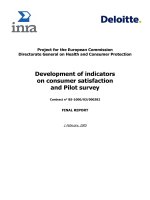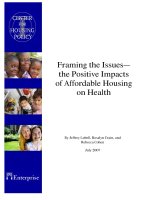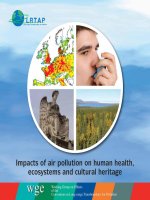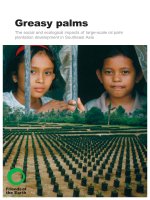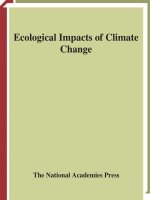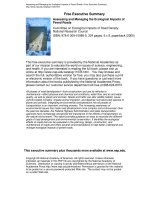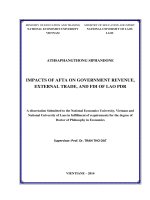Ecological impacts of tsunamis on coastal ecosystems
Bạn đang xem bản rút gọn của tài liệu. Xem và tải ngay bản đầy đủ của tài liệu tại đây (17.15 MB, 412 trang )
Ecological Research Monographs
Jotaro Urabe
Tohru Nakashizuka
Editors
Ecological Impacts
of Tsunamis on
Coastal Ecosystems
Lessons from the
Great East Japan Earthquake
Ecological Research Monographs
Series editor
Yoh Iwasa
More information about this series at />
Jotaro Urabe • Tohru Nakashizuka
Editors
Ecological Impacts
of Tsunamis on Coastal
Ecosystems
Lessons from the Great East Japan
Earthquake
Editors
Jotaro Urabe
Graduate School of Life Sciences
Tohoku University
Sendai, Japan
Tohru Nakashizuka
Graduate School of Life Sciences
Tohoku University
Sendai, Japan
ISSN 2191-0707
ISSN 2191-0715 (electronic)
Ecological Research Monographs
ISBN 978-4-431-56446-1
ISBN 978-4-431-56448-5 (eBook)
DOI 10.1007/978-4-431-56448-5
Library of Congress Control Number: 2016955041
© Springer Japan 2016
This work is subject to copyright. All rights are reserved by the Publisher, whether the whole or part of
the material is concerned, specifically the rights of translation, reprinting, reuse of illustrations, recitation,
broadcasting, reproduction on microfilms or in any other physical way, and transmission or information
storage and retrieval, electronic adaptation, computer software, or by similar or dissimilar methodology
now known or hereafter developed.
The use of general descriptive names, registered names, trademarks, service marks, etc. in this publication
does not imply, even in the absence of a specific statement, that such names are exempt from the relevant
protective laws and regulations and therefore free for general use.
The publisher, the authors and the editors are safe to assume that the advice and information in this book
are believed to be true and accurate at the date of publication. Neither the publisher nor the authors or the
editors give a warranty, express or implied, with respect to the material contained herein or for any errors
or omissions that may have been made.
Cover illustration: Left: Matsukawa-ura Lagoon in Fukushima Prefecture (photo by Takao Suzuki);
right: a coastal pine forest in Iwate Prefecture (photo by Tohru Nakashizuka), damaged and destroyed,
respectively, by the tsunamis caused by the Great East Japan Earthquake in March 2011.
Printed on acid-free paper
This Springer imprint is published by Springer Nature
The registered company is Springer Japan KK
The registered company address is: Chiyoda First Bldg. East, 3-8-1 Nishi-Kanda, Chiyoda-ku, Tokyo
101-0065, Japan
Preface
Disturbance is a key concept in understanding various ecological issues such as
biodiversity, community assemblages, ecosystem stability and resilience, and nature
conservation. Earthquakes and resulting tsunamis are extreme examples of such
disturbance. Because these events can result in rare but intensive disturbance of
large areas, monitoring and examination of organismal response to these events at
species, population, community and landscape levels provide invaluable opportunity to uncover the ecological significance of large-scale disturbances.
In our society, earthquake and tsunami disasters have the potential to cause great
loss to human lives and properties. Therefore, society has made extensive efforts to
reduce the risks of such natural disasters. However, knowledge of biological and
ecological responses regarding such extreme disturbances is also essential and has
led to the recent development of the Ecosystem based Disaster Risk Reduction
(EcoDRR). Ecosystems routinely provide us with important ecosystem services.
Therefore, a harmonious balance needs to be considered between ecosystem properties and man-made infrastructure to reduce disturbance risk to ecosystems.
The Great East Japan Earthquake on 11 March 2011, registering 9.0 on the
Moment Magnitude Scale (Mw), caused large tsunamis that struck the Pacific coastline of eastern Japan (Tohoku), creating intense high impact disturbances to various
ecosystems along the coastline. In advance of the disaster, the coastal ecosystems in
Tohoku area had been frequently visited and studied by animal and plant ecologists,
in part due to the great natural value of the area. Immediately after the Great East
Japan Earthquake it was difficult to access and examine coastal ecosystems in detail
because infrastructures were heavily damaged in the region. However, as soon as
possible following the disturbance, a number of ecologists initiated studies to examine and evaluate the impacts and implications of the Great East Japan Earthquake
tsunamis to these coastal ecosystems in the Tohoku area. This book is a compilation
v
vi
Preface
of edited articles from these studies. Most authors of these articles have previously
studied the coastal ecosystems in Tohoku area prior to this earthquake and thus were
highly qualified to describe the changes in the ecosystems as a result of the
tsunamis.
This book begins by presenting an outline of the Great East Japan Earthquake
disaster (Chap. 1). The book is then divided into two parts; Part I reports on 14
aquatic studies (Chaps. 2, 3, 4, 5, 6, 7, 8, 9, 10, 11, 12, 13, 14, and 15) and Part II is
composed of eight terrestrial studies (Chaps. 16, 17, 18, 19, 20, 21, 22, and 23).
The Great East Japan Earthquake affected various aquatic ecosystems not only
because of the tsunamis but also as a result of land subsidence. In Chaps. 2, 3, 4, and
5, responses of sessile animal populations and rocky shore communities to these
disturbances are described. In Chap. 6, successional changes in a subtidal benthic
community after the tsunami disturbances are analyzed. Among the coastal ecosystems, tidal flats were probably the most vulnerable to disturbances by the tsunamis
and land subsidence. In the following six chapters (Chaps. 7, 8, 9, 10, and 11),
ecological impacts of these disturbances to the tidal flat communities are reported.
These studies uncover how and why the community response differed depending on
the tidal flats. In Chaps. 12, 13, and 14, direct and indirect effects of disturbances by
the earthquake on molluscan populations are described. These studies serve to
understand species-specific differences in vulnerability to the tsunami disturbances.
In addition to natural ecosystems, the earthquake and resulting tsunamis significantly damaged coastal infrastructures. Accordingly, harmful substances such as
fuels were released from some storages facilities in the coastal areas of Tohoku
region. In Chap. 15, the ecological consequences of these fuel spills and the subsequent conflagration are reported.
The Great East Japan Earthquake also seriously affected terrestrial vegetation
along the Tohoku Pacific coastal area. In Chapter 16, a remote sensing study of the
impacts of the tsunamis on a wide range of coastal ecosystems are reported.
Chapters 17 and 18 give accounts of the damages and recovery of coastal sand dune
communities, in particular the role of buried seeds in the recovery process as seen
in Chap. 18. In Chapter 19, a comprehensive evaluation of the tsunami impacts on
coastal flora is presented. In addition, damages to the coastal pine forests by the
tsunamis are analyzed in detail in Chap. 20. The tsunamis also created wetlands
behind sand dunes. Chapter 21 reports on unexpected disturbance outcomes that
lead to a revival of certain endangered species. In Chapter 22, the effect of the tsunamis on forest vegetation and its recovery are reported. And, in the final chapter
(Chapter 23), the comprehensive monitoring system about the impact and recovery
of ecosystems conducted by Ministry of Environment Japan, is introduced.
Since these are natural events, earthquakes and tsunamis will inevitably recur
sometime and somewhere in the future. However, such large and rare disturbances
are limited, and thus so is ecological knowledge about these disturbances. We
believe that the studies in this book are useful not only to deepen our understanding
Preface
vii
of these disturbances in ecology but also to seek a way for practical applications of
EcoDRR to coastal ecosystems.
We acknowledge Drs. Yoh Iwasa, Tetsukazu Yahara and Takashi Saitoh for their
recommendations and encouragements for publishing this book. Finally, we would
like to dedicate this book to all the peoples who fell victim and suffered greatly due
to the Great East Japan Earthquake and subsequent tsunamis.
Sendai, Japan
Jotaro Urabe
Tohru Nakashizuka
Contents
1
Outline of the Great East Japan Earthquake .......................................
Naoaki Shimada
1
Part I Aquatic Ecosystems
2
3
4
5
6
Normality of Succession of an Intertidal Community
After the Great East Japan Earthquake ...............................................
Ryusuke Kado and Nobuyoshi Nanba
11
Rocky Intertidal Zonation: Impacts and Recovery from
the Great East Japan Earthquake .........................................................
Takashi Noda, Aiko Iwasaki, and Keiichi Fukaya
25
Quantitative Evaluation of the Impact of the Great East Japan
Earthquake and Tsunami on the Rocky Intertidal Community ........
Aiko Iwasaki, Keiichi Fukaya, and Takashi Noda
35
Rocky Intertidal Barnacle Population Dynamics: Impacts
and Recovery from the Great East Japan Earthquake .......................
Takashi Noda, Masayuki Sakaguchi, Aiko Iwasaki,
and Keiichi Fukaya
Ecological Impacts of the Great East Japan Earthquake
and Tsunami and the Following Succession on
the Subtidal Macrobenthic Community in Onagawa
Bay, Northeastern Japan, with Special Reference
to the Dominant Taxon, Polychaetes .....................................................
Hirokazu Abe, Genki Kobayashi, and Waka Sato-Okoshi
47
59
ix
x
7
Contents
Ecological Consequences of the Tsunamis Caused by
the Great East Japan Earthquake and Subsequent
Disturbance Events in a Shallow Brackish Lagoon
in Sendai Bay, Japan ...............................................................................
Gen Kanaya, Takao Suzuki, Keiichi Kanou,
Tomohiko Kondoh, Waka Sato-Okoshi, and Eisuke Kikuchi
85
8
Impacts of the Tsunami Disaster Caused by the
Great East Japan Earthquake on the Benthic Communities
and Their Recovery in Tidal Flats of Matsukawaura
Lagoon, Soma, Japan .............................................................................. 105
Takao Suzuki
9
Colonization of the Restored and Newly Created Tidal Flats
by Benthic Animals in the Sanriku Region of Northern Japan .......... 117
Masatoshi Matsumasa and Kyoko Kinoshita
10 Effects of the Great East Japan Earthquake
on Intertidal Macrobenthos in Iwate Prefecture.................................. 133
Kyoko Kinoshita and Masatoshi Matsumasa
11 Ecological Responses of Macrobenthic Communities
in Tidal Flats to Disturbances by the Great East Japan
Earthquake .............................................................................................. 151
Tatsuki Nishita, Wataru Makino, Takao Suzuki, and Jotaro Urabe
12 The Effects of Liquefaction, Tsunami, and Land
Subsidence on Intertidal Mollusks Following
the Great East Japan Earthquake ......................................................... 165
Kenji Okoshi
13 Ecological Impacts and Recovery of Molluskan Populations
After the Tsunami Struck Around Matsushima Bay and
Sendai Bay, Miyagi Prefecture, Northeastern Japan ........................... 179
Shin’ichi Sato and Tomoki Chiba
14 Genetic Structures of Laguncula pulchella Metapopulations
Along the Northeast Coast of Japan After the Tsunamis
Caused by the Great East Japan Earthquake ...................................... 209
Hajime Ohtsuki, Takao Suzuki, Kyoko Kinoshita,
Gen Kanaya, Takuto Hirama, Shin’ichi Sato,
Kiyotaka Shibata, Kenji Okoshi, and Jotaro Urabe
15 Impacts of Fuel Spills Caused by the Great East Japan
Earthquake and Tsunami on the Subtidal
Soft-Bottom Communities of a Semi-enclosed
Bay Located on the Sanriku Coast ........................................................ 223
Gen Kanaya, Hideaki Maki, Fumihiro Chiba, Kazuki Miura,
Shin-ichi Fukuchi, Hisao Sasaki, and Osamu Nishimura
Contents
xi
Part II Terrestrial Ecosystems
16 Impact of the Great East Japan Earthquake and Tsunami
on Coastal Vegetation and Landscapes in Northeast Japan:
Findings Based on Remotely Sensed Data Analysis ............................. 253
Keitarou Hara, Yi Zhao, Mizuki Tomita, Noritoshi Kamagata,
and Yunqing Li
17 Susceptibility of Sandy Beach Flora to the Great East
Japan Earthquake and Tsunami in Northern Tohoku, Japan ............ 271
Daisuke Hayasaka, Katsumasa Yamada, and Taizo Uchida
18 The Species Composition of Buried Seeds of Seashore Vegetation
Disturbed by the Great East Japan Earthquake and Tsunami
in Northern Tohoku, Japan .................................................................... 289
Motohiro Kawanishi, Daisuke Hayasaka, and Naoaki Shimada
19 Plant Diversity and Considerations for Conservation
of It in Infrastructure Reconstruction Planning After the
Great East Japan Earthquake and Tsunami of 2011 .......................... 311
Takahide Kurosawa
20 Regeneration of Damaged Coastal Forests Caused
by the Great East Japan Earthquake and Tsunami ............................ 337
Tomoki Sakamoto
21 Flora of Freshwater Wetlands in the Tsunami-Affected
Zone of the Tohoku Region .................................................................... 361
Mahoro Suzuki
22 Influences of Large, Infrequent Disturbance Caused
by Tsunami on Coastal Forest Communities........................................ 383
Mizuki Tomita, Yoshihiko Hirabuki, Hiroshi Kanno,
and Keitarou Hara
23 Survey of Impact of the Great East Japan Earthquake
on the Natural Environment in Tohoku Coastal Regions.................... 395
Osamu Ichihashi, Daisuke Horii, Yoshio Tsukamoto,
Takashi Someya, Hiroaki Terasawa, Shinji Iki, Maki Isoda,
Kotaro Goto, Emiko Ariyasu, Takashi Inoue, and Shintaro Abe
Chapter 1
Outline of the Great East Japan Earthquake
Naoaki Shimada
Abstract An earthquake occurred at 2:46 P.M. on March 11, 2011, off the Pacific
coast of Tohoku. It measured 9.0 Mw on the moment magnitude scale and was the
largest recorded earthquake in known Japanese history. Extremely tall tsunami
waves were observed along with this earthquake. Ogatsu-cho in Ishinomaki City
had the highest level of tsunami flooding at 34.94 m and Omoe in Miyako City had
the highest tsunami run-up at 38.38 m. This earthquake brought about enormous
damages including 19,418 casualties, 2592 missing persons, and 121,809 completely destroyed buildings. It was decided to call this disaster arising from the
earthquake the “Great East Japan Earthquake” at the Cabinet Meeting on April 1,
2011.
Keywords Great East Japan Earthquake • Tsunami • State of damage
1.1
The Earthquake
The 2011 off the Pacific coast of Tohoku Earthquake occurred at 2:46 P.M. on
March 11, 2011. It measured 9.0 Mw on the moment magnitude scale and was the
largest recorded earthquake in Japanese history. The hypocenter was located at
38°06.2′ north latitude, 142°51.6′ east longitude, and a depth of 24 km. The hypocenter lay on the Sanriku coast (approximately 130 km east-southeast of the Oshika
Peninsula in Miyagi Prefecture) (Japan Meteorological Agency 2012b).
By the standards of the Japan Meteorological Agency, the largest measure on the
seismic scale, a seven, was observed in Kurihara City in Miyagi Prefecture. In 37
municipalities of the four prefectures of Miyagi, Fukushima, Ibaraki, and Tochigi, a
reading above six on the seismic scale was observed. The locations that were
observed to have a reading on the seismic scale of six or greater (from Yahaba-cho
in Iwate Prefecture to Narita City in Chiba Prefecture) extended over approximately
N. Shimada (*)
Faculty of Policy Studies, Iwate Prefectural University,
152-52 Sugo, Takizawa, Iwate 020-0693, Japan
e-mail:
© Springer Japan 2016
J. Urabe, T. Nakashizuka (eds.), Ecological Impacts of Tsunamis on Coastal
Ecosystems, Ecological Research Monographs,
DOI 10.1007/978-4-431-56448-5_1
1
2
N. Shimada
Fig. 1.1 Seismic scale in the Tohoku Area for the 2011 off the Pacific coast of Tohoku Earthquake
(Figure created using material from a publication by the Japan Meteorological Agency (2012a))
430 km, suggesting that the strong vibrations extended over a wide area. Strong
vibrations were observed mainly in Miyagi Prefecture but also from the center of
Fukushima to the eastern part of the prefecture and in southern Iwate Prefecture
(Fig. 1.1). The vibrations of the earthquake were observed throughout all of Japan
with the exception of Miyazaki Prefecture and Okinawa Prefecture (Japan
Meteorological Agency 2012a).
1
Outline of the Great East Japan Earthquake
3
The area around the Oshika Peninsula in Miyagi Prefecture was moved horizontally 5.4 m toward east-southeast by the earthquake. The area between Kamaishi in
Iwate Prefecture and Natori in Miyagi Prefecture was moved horizontally more than
3 m and crustal change was observed over a wide area (“Summary of the Amount
of Change by the Coastal Observation Authority”: checked on 5/7/2016). In general it was a movement toward
the hypocenter in all locations (“Electronic Reference Points for Crustal Change
Received from Continuous GPS Observation” (Geospatial Information Authority of
Japan): checked on
5/7/2016).
In the upward and downward movement of the crust, a significant subsidence
was observed on the Pacific coast of Tohoku. The area around the Oshika Peninsula
in Miyagi Prefecture had the greatest subsidence with a crustal subsidence of
approximately 1.1 m. From Yamada in Iwate Prefecture to Iwaki in Fukushima
Prefecture, there was a crustal subsidence of more than 0.5 m (Fig. 1.2a). Crustal
changes were also observed over a wide area from Hokkaido to the Kinki region
(“Electronic Reference Points for Crustal Change Received from Continuous GPS
Observation” (Geospatial Information Authority of Japan): />chibankansi/chikakukansi40005.html, checked on 5/7/2016).
1.2
The Tsunamis
Extremely tall tsunami waves were observed along with this earthquake. The tsunami gauges set up by Japan Meteorological Agency and others on the Pacific coast
of Tohoku were unable to collect accurate data due to power outages, leakage, and
damage from the tsunami (Japan Meteorological Agency 2012b). According to
Haraguchi and Iwamatsu (2011a, b) who carried out a field survey of traces of the
tsunamis, such as those left behind in buildings, through the 2011 Tohoku Earthquake
Tsunami Joint Survey Group, Oguchi-cho in Ishinomaki City had the highest level
of tsunami flooding at 34.94 m, and Omoe in Miyako City had the highest tsunami
run-up at 38.38 m. The totaled results for each municipality are shown in Fig. 1.2b.
This shows that the locations with tsunami flood height above 20 m and with exceptionally large tsunamis were developed ria coast areas of Sanriku. Large tsunamis
and tsunami flooding over 10 m in height were observed across a broad area from
Hachinohe City in Aomori Prefecture to Souma City in Fukushima Prefecture.
Locations where tsunami flooding greater than 5 m in height was observed extended
across approximately 580 km in a straight line from Misawa City in Aomori
Prefecture at the northernmost point to Asahi City in Chiba Prefecture at the southernmost point (Haraguchi and Iwamatsu, 2011a, b). Tsunamis above 1 m in height
were observed along the Pacific coast from Hokkaido to Kagoshima and in the
Bonin Islands. Tsunamis were also observed along the Pacific coast of various other
countries. A 2.47 m tsunami was observed in Crescent City in the United States and
a 2.45 m tsunami was observed in Arica, Chile. There were also observations of
tsunamis over 2 m in height in many areas (Japan Meteorological Agency 2012b).
Fig. 1.2 Earth subsidence amount (a), Height of Tsunami Flooding (b), and Municipal observations (c) on the Pacific Coast of the Tohoku Region. The highest
value for each municipality is displayed. (a) consists of information published by the Geospatial Information Authority of Japan ( />BOUSAI/h23_tohoku.html) and (b) consists of information from Haraguchi and Iwamatsu (2011a, b)
4
N. Shimada
1
Outline of the Great East Japan Earthquake
5
Table 1.1 Extent of tsunami flooding by prefecture and land use in the 2011 off the Pacific coast
of Tohoku earthquake
Flooded area (km2)
Building
and
arterial
traffic
sites
Aomori
3
Iwate
21
Miyagi
74
Fukushima 15
Ibaraki
3
Chiba
4
Total
120
Ratio of flood area to non-flooded
area (%)
Arable Rivers,
Building
Arable Rivers,
land,
lakes,
and
land,
lakes,
forests, marshes,
arterial
forests, marshes,
golf
beaches,
traffic
golf
beaches,
Other courses etc.
Total sites
Other courses etc.
5
5
11
24 11
21
21
47
9
18
10
58 37
15
31
17
27
183
43
327 23
8
56
13
10
67
19
112 13
9
60
17
5
3
11
23 16
23
14
46
1
7
6
17 15
8
40
37
58
283
100
561 21
10
50
18
Created using materials from (the Geospatial
Information Authority of Japan)
There was flooding damage due to the tsunamis arising from this earthquake over
a broad area extending from Aomori to Chiba Prefectures (Table 1.1). Large parts
of coastal areas of the Miyagi and Fukushima Prefectures were flooded, but the area
flooded was not so broad in Iwate Prefecture where there were high flood levels. It
is thought that this is because the ria coast in the southern part of Iwate Prefecture
and the sea cliffs in the northern part are developed while the plains areas are not
developed.
The ratio for the extent of tsunami flooding by land use for each prefecture is
shown in Table 1.1. Arable land, forests, and golf courses had the most tsunami
flooding between all of the regions at 50 %. Next were areas used for buildings and
roads at 21 %. The rate of flooding for arable land, forests, and golf courses in
Miyagi and Fukushima prefectures was at 56 % and 60 %, respectively, while the
rate of flooding was larger in areas used for buildings and roads for Iwate Prefecture
at 37 %. It is thought that this difference is due to the concentration of urban areas
along the narrow coastal plains in Iwate Prefecture because of the ria coast and sea
cliffs, while in the Miyagi and Fukushima prefectures the coastal plains are broad
and the arable land is distributed widely.
1.3
State of Damage
This earthquake brought about enormous damages including 19,418 casualties,
2592 missing persons, 6220 injured, 121,809 completely destroyed buildings,
278,496 half destroyed buildings, and 744,190 partially damaged buildings (current
as of March 1, 2016) (Table 1.2). Around 470,000 evacuees occurred directly
N. Shimada
6
Table 1.2 Human and building losses from the 2011 off the Pacific coast of Tohoku earthquake
Aomori
Iwate
Miyagi
Fukushima
Other
Total
Deceased
3
5132
10,549
3626
108
19,418
Missing
1
1124
1239
225
3
2592
Injured
110
211
4145
183
1571
6220
Total
destruction
308
19,597
82,999
15,169
3736
121,809
Half
destroyed
701
6571
155,129
78,960
37,135
278,496
Partially
destroyed
1005
18,959
224,195
141,454
358,577
744,190
Created from materials from the Fire and Disaster Management Agency (2016) (a.
go.jp/bn/280308_%E7%AC%AC153%E5%A0%B1.pdf)
Table 1.3 Amount of monetary losses in agriculture, forestry, and fisheries
Iwate
Miyagi
Fukushima
Agriculture
(billion yen)
68.8
550.5
239.5
Forestry
(billion yen)
29.6
55.1
49.5
Fisheries
(billion yen)
564.9
689.6
92.4
Total damage
(billion yen)
663.3
1295.20
381.4
Created from information from the Tohoku Regional Agricultural Administration Office, Ministry
of Agriculture, Forestry and Fisheries of Japan (2016)
/>
following the earthquake disaster. Even in February 2016, 5 years after the disaster,
there were still around 174,000 people living as evacuees, such as those residing in
temporary housing (“The Present State of and Efforts Towards Reconstruction”
(Reconstruction Agency): check on 5/7/2016).
The damages to the agriculture, forestry, and fisheries industries totaled to 1.12
trillion yen for the agricultural and forestry industries and 1.26 trillion yen for the
fisheries industry, a total of approximately 2.38 trillion yen (“Efforts to Support the
Reconstruction of the Agriculture, Forestry, and Fishery Industries Following the
Tohoku Earthquake” (Ministry of Agriculture, Forestry and Fisheries of Japan):
checked on
5/7/2016). The conditions in Iwate, Miyagi, and Fukushima Prefectures, where
damage was particularly significant, are collected in Table 1.3. Fisheries suffered
the largest monetary loss in Iwate. In Miyagi the agricultural and fishery industries
suffered around the same monetary losses, while agriculture suffered the largest loss
in Fukushima (“Efforts of the Tohoku Regional Agricultural Administration Office
with the Restoration of Agriculture and Agricultural Communities”, Tohoku
Regional Agricultural Administration Office, Ministry of Agriculture, Forestry and
Fisheries of Japan: />pdf/fukkou160309.pdf, checked on 5/7/2016).
The affected agricultural areas amounted to roughly 20,000 ha in these three prefectures with around 70 % of the area being in Miyagi Prefecture (Table 1.4). Among
1
7
Outline of the Great East Japan Earthquake
Table 1.4 Conditions in agricultural land restoration
Iwate
Miyagi
Fukushima
Total
Affected
agricultural
area
730
14,340
5460
20,530
Area
reopened for
agriculture
by March
2016
490
12,660
1820
14,970
Area with
instructions
for
evacuation
2120
2120
Agricultural
land put to
another use
60
630
580
1270
Agricultural
land restoration
rate (%)
67.1
88.3
33.3
72.9
Created from information from the Tohoku Regional Agricultural Administration Office, Ministry
of Agriculture, Forestry and Fisheries of Japan (2016)
/>
Table 1.5 Weight of catches, value of catches, and comparisons with before the earthquake
disaster
Iwate
Miyagi
Fukushima
Total
February 2015–January 2016
Weight of catch
Value of catch
(tons)
(billion yen)
93,000
16
245,000
58
6000
1
345,000
74.3
Comparison to before the
earthquake disaster
Weight of catch
67 %
79 %
59 %
74 %
Value of catch
82 %
98 %
36 %
93 %
Created from information from the Fisheries Agency of Japan (2016)
/>
these agricultural lands, 73 % in total has been restored. However, in Fukushima
Prefecture, only 33 % of agricultural land has been restored (“Efforts to Support the
Reconstruction of the Agriculture, Forestry, and Fishery Industries Following the
Tohoku Earthquake” (Tohoku Regional Agricultural Administration Office, Ministry
of Agriculture, Forestry and Fisheries of Japan): checked on 5/7/2016).
In the fishing industry, approximately 29,000 fishing boats and 319 fishing harbors were damaged. The weight of catches and the value of catches also fell significantly (Table 1.5). The objective for restoring fishing boats was 20,000 boats and
approximately 18,000 boats, or 91 %, have been restored. Among fishing harbors
damaged, 311 have been restored until 2016 so that they are able to land boats. The
weight of the catch has recovered 74 % compared to before the disaster and the
value of the catch has recovered 93 %, but the situation remains still poor in
Fukushima Prefecture (Table 1.5) (“The Current Situation and Issues with Restoring
the Fisheries Industry” (Fisheries Agency of Japan): />yosan/23/pdf/1603kadaigenjou.pdf, checked on 5/7/2016).
It was decided to call this disaster arising from the earthquake the “Great East
Japan Earthquake” at the Cabinet Meeting on April 1, 2011.
8
N. Shimada
References
Haraguchi T, Iwamatsu A (2011a) Detailed maps of the impacts of the 2011 Japan Tsunami Vol. 1:
Aomori, Iwate and Miyagi prefectures. Koko-Shoin Publishers, Tokyo, in Japanese with
English abstract
Haraguchi T, Iwamatsu A (2011b) Detailed maps of the impacts of the 2011 Japan Tsunami Vol. 2:
Fukushima, Ibaraki and Chiba prefectures. Koko-Shoin Publishers, Tokyo, in Japanese with
English abstract
Japan Meteorological Agency (2012a) Monthly report on earthquakes and volcanoes in Japan
December 2012: 177–187 (in Japanese)
Japan Meteorological Agency (2012b) Report on The 2011 off the Pacific coast of Tohoku
Earthquake. Technical Report of the Japan Meteorological Agency. 133:479pp. (in Japanese
with English abstract)
Part I
Aquatic Ecosystems
Chapter 2
Normality of Succession of an Intertidal
Community After the Great East Japan
Earthquake
Ryusuke Kado and Nobuyoshi Nanba
Abstract On March 11, 2011, the Great East Japan Earthquake occurred with an
epicenter off the Tohoku area in northern Honshu, Japan. By the Tohoku earthquake
tsunami and following ground subsidence, coastal organisms seem to have experienced various physiological and biological effects. We have continuously examined
influence of the earthquake to the intertidal organisms at Sakihama in Iwate
Prefecture for 4 years since August 2011 by using video camera footage. The surveyed site between E.H.W.S. and E.L.W.S. that has about a 180 cm tidal range
experienced a subsidence of 130 cm due to the earthquake. The first colonizers on
the newly submerged substrate were barnacles Semibalanus cariosus. The hard
uneven substrate formed by the settlement of the barnacle facilitated the recruitment
of the green alga Ulva intestinalis first and then the mussel Mytilus galloprovincialis followed. This multilayered community structure increased in species richness
for 2 years. However, the species richness subsequently decreased with increasing
abundance of the sea urchin Strongylocentrotus nudus which was the causative species in rocky shore denudation in this area before the earthquake. This biological
succession was almost the same as that of a previous experiment from 2004 to 2006
which was carried out to examine the ecological roles of S. cariosus using test plates
installed at the same location. The main difference between the two biological successions during the two experimental periods was the occurrence of a new alien
barnacle Perforatus (Balanus) perforatus after the earthquake. According to the
monthly monitoring data of the sedentary organisms on the test plates set on the
jetty wall in Sakihama, this barnacle was found for the first time in 2012 and has
been settling on them every summer. Just after the earthquake, many barges and
tugboats came from various localities in Japan for reconstruction activities along
the Tohoku coast. One barge, registered in Niigata, a city on the Japan seacoast
where P. perforatus has become common, was anchored near the research site in
2013 and had this barnacle on its hull and fenders. Since the settlement of the alien
R. Kado (*) • N. Nanba
School of Marine Biosciences, Kitasato University,
1-15-1, Kitasato, Minami-ku, Sagamihara, Kanagawa 252-0373, Japan
e-mail:
© Springer Japan 2016
J. Urabe, T. Nakashizuka (eds.), Ecological Impacts of Tsunamis on Coastal
Ecosystems, Ecological Research Monographs,
DOI 10.1007/978-4-431-56448-5_2
11
12
R. Kado and N. Nanba
barnacle occurred after the earthquake, it was likely that these boats played a role in
the dispersion of P. perforatus into this area. This possibility implies that the earthquake affected on the intertidal communities not only directly via the tsunamis and
subsidence but also indirectly via anthropogenic activities.
Keywords Biological succession • Intertidal community • The Great East Japan
Earthquake • Tsunami • Alien species
2.1
Introduction
The littoral zone is a transitional ecotone formed in between tides. It is 1.7–1.8 m in
height along the northeast coast of Honshu Island, Japan, and the vertical zonation
formed by several major dominant organisms has been shown to be dependent on
environmental gradients (Raffaelli and Hawkins 1996). Semibalanus cariosus, a
barnacle widely distributing in northern parts of the North Pacific, is one of the
dominant species forming a clear zonal distribution. This species is called a thatched
barnacle as it has many radiating ribs on its shell (Newman and Abbott 1980) and
forms a hard substratum for other organisms such as the green alga Ulva
(Enteromorpha) intestinalis, red alga Analipus japonicus, and mussels Mytilus spp.
in the littoral zone and Undaria pinnatifida and Laminaria religiosa in the upper
sublittoral zone (personal observation). Such a multilayered structure based on S.
cariosus has provided interstitial spaces for small crustaceans, mollusks, and annelids and has contributed to the increase in biodiversity of the littoral and upper
sublittoral zones (Kado, unpublished data). Mussels in particular could not recruit
in the intertidal zone on flat concrete jetty walls without the presence of the shells
of the thatched barnacle (Kado, unpublished data).
However, S. cariosus had a mass mortality during the period from 1998 to 1999
(for unknown reasons), and most of them had dropped off from the jetty walls along
the Sanriku coast (Kado, unpublished data). As a result, the community on the jetty
walls was simultaneously lost with the exfoliated barnacles. Accordingly, only several species dominated in the littoral zone on the jetty walls of the Sanriku coast
before 2011. For example, the surf barnacle, Chthamalus challengeri, occurred
abundantly in the upper littoral; the oyster, Crassostrea gigas, was abundant in the
middle littoral; and the serpulid, Hydroides ezoensis, dominated in the zone just
below C. gigas.
A previous study showed that at a jetty wall of the Sanriku coast, S. cariosus
recruited every year since 1989 on test plates that were set at 40 cm below the mean
sea level (M.S.L.) along the jetty wall, although the recruited individuals varied
according to years (Kado 2003a). However, juveniles of the barnacle have been
unable to establish a clear zonation pattern since 2000 on the jetty wall. The low
barnacle abundance on the jetty wall may have been due to predation by the sea
urchin Strongylocentrotus nudus, which has increased recently along the Sanriku
2
13
Normality of Succession of an Intertidal Community…
coast (Fujiwara 2008). S. nudus consumed not only barnacles but also other sedentary organisms like algae, mussels, and other organisms before they are able to grow
large enough to mature. Therefore, this species was often regarded as a causative
species of rocky shore denudation in this area (Kado 2006).
On March 11 in 2011, the Great East Japan Earthquake occurred along northeast
coast of Honshu in Japan and caused large tsunamis and ground subsidence. In this
study, to understand the communities grown on jetty walls on the Sanriku coast, we
first briefly described results of the experiment that was carried out before the earthquake on the jetty wall at Sakihama on the Sanriku coast. Based on the results, I
hypothesized that biological interactions such as predation by sea urchins were
principal factors regulating structures of the intertidal communities on the jetty
walls. We examined the hypothesis by comparing some results of an experiment
before the earthquake and continual observation of the community developed on a
jetty wall after the earthquake. In addition, we examined the possibility that an invasion of a barnacle species that was presumably introduced by anthropogenic activities after the earthquake has played a pivotal role in determining the community
structure on the jetty walls on the Sanriku coast in recent years.
2.2
An Experiment Before the Great East Japan Earthquake
To examine the ecological role and pattern of formation of littoral communities, we
conducted an experiment on a wall of the Second Sakihama Jetty, Iwate Prefecture,
by using plastic test plates as an artificial substrate from 2004 to 2006 (Fig. 2.1). In
this experiment, we prepared three treatments each composed of three PVC test
plates (25 × 25 cm) (Fig. 2.2); sets A and B were plates with S. cariosus settled on
their surface. The S. cariosus were allowed to settle on the plates which were set in
the intertidal at Sakihama in April in 2004 and grew to around 10 mm in diameter
Sakihama
Survey
site
Okirai Bay
Fig. 2.1 Maps of Okirai Bay, Iwate Prefecture, showing the Sakihama area and the Second Jetty
where the present study was performed
14
R. Kado and N. Nanba
Jetty
A
10 cm
B
C
40 cm
Below
M.S.L.
25 cm
10 m
Fig. 2.2 Diagram showing the schematic arrangement of the test plates set on the wall of the jetty
for assessing the roles of the barnacle Semibalanus cariosus and sea urchin Strongylocentrotus
nudus in community assemblage processes. Three test plates (25 cm2 on each side) were set inside
three stainless frames. Plates A and B with the barnacles already settled on the plates before this
experiment were placed 10 cm apart from the wall (Plate A) using the stainless frame guard and
placed directly on the wall (Plates B), respectively. Plates C without barnacles on the plates was
placed directly on the wall
when the experiment started. The third set, set C, was used as a control without any
sessile animals on the plates. Set A was placed 10 cm apart from the jetty wall surface to decrease chance of predation by sea urchins, and set B and set C were placed
directly on the wall where sea urchins, S. nudus, were distributed. All of these plates
were installed at 40 cm below MSL during June of 2004 (Fig. 2.2) when the experiment was initiated. Then, the number of species and total weight including the plate
itself were investigated every 2 months over 2 years.
An outline of the results is as follows. In the autumn, many mussels M. galloprovincialis had settled only on the plates with the barnacles and not on the plates
without barnacles, i.e., control plates (set C). In May 2005, i.e., 11 months later
from the start of experiment, small numbers of surf barnacles and green and red
macroalgae had colonized on the set C (Fig. 2.3C). Contrastingly, set A and B plates
showed a clear two-layered structure with many grown mussels that covered over
the barnacles. The barnacles lived and even grew to large individuals underneath the
upper layer of mussels. Green and red macroalgae grew moderately on the set A
plates but were limited on set B plates (Fig. 2.3A, B). Between the space with barnacles and the mussel canopy, some interstitial organisms such as small snails were
found on the plates of all treatments.
In May 2006, 2 years after the start of the experiment, a few C. challengeri and
C. gigas and small numbers of green and red algae were found on the set C plates.
On the set A plates, mussels had continually grown on the barnacles which were still
2
Normality of Succession of an Intertidal Community…
15
Fig. 2.3 Succession of the community assemblages on the test plates manipulated with the three
different conditions: (A) plates started with barnacle Semibalanus cariosus and placed them 10 cm
apart from the wall that inhibited access of sea urchins; (B, C) plates started with or without S.
cariosus, respectively, and were placed directly on the wall enabling access of sea urchins
alive but grew little, and green and red algae flourished on the mussels. On the set
B plates, number of the mussels and barnacles decreased and bare spaces appeared
with a few oysters and green algae. In December 2006, 30 months after the start of
experiment, communities on the set C and B plates showed almost the same structure as that found on the natural jetty walls where only C. challengeri and C. gigas
dominated. On the A set plates, however, a number of large mussels dominated
externally; the reddish barnacle Megabalanus rosa settled on the mussel shells and
S. cariosus attached underneath. In addition, a number of small snails, annelids,
flatworms, and amphipods were found interstitially on the A set plates.
These differences in communities between the A and B set plates and the A and
C set plates showed that the sea urchin S. nudus and barnacle S. cariosus are key
species in the littoral community. Excess density of the former resulted in a “sea
urchin barren,” and recruitment of S. cariosus contributed to the formation of a littoral community with a high biodiversity. Inside the community, the growth of
S. cariosus was inhibited by overgrowth of the mussel M. galloprovincialis.
However, the barnacle seemed to benefit from the cover of the mussels because they
were apparently protected from predation by sea urchins and predatory gastropods.
On the other hand, M. galloprovincialis received an advantage from the barnacle
since the barnacles form a substrate for the settlement of this mussel although they
